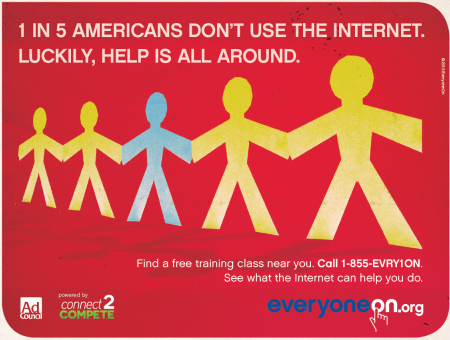EveryoneOn: The Importance of Digital Literacy Skills
 Despite the seeming prevalence and importance of technology, close to 1 in 5 Americans do not use the Internet. This lack of Internet access means that over 60 million Americans do not have the same access to valuable job-searching opportunities, health care information, education resources, and more.
Despite the seeming prevalence and importance of technology, close to 1 in 5 Americans do not use the Internet. This lack of Internet access means that over 60 million Americans do not have the same access to valuable job-searching opportunities, health care information, education resources, and more.
EveryoneOn is deeply committed to not only bringing affordable Internet and devices to those who don’t have it, but also to promoting the importance and value of digital literacy. Public libraries are key to the success of this effort because of the demonstrated commitment to providing free access to the Internet as well as to improving people’s skills (e.g. using a mouse, applying for jobs online, or creating email accounts).
Here are some Frequently Asked Questions about EveryoneOn and digital literacy:
1. How can my library get involved?
One of the best ways to become involved is to update your library’s “profile” in the EveryoneOn Training Locator Tool database. There is a record in this database for almost every public library location in the United States with basic information such as address and phone number. Other organizations such as Job Centers and Public Computer Centers are also part of the database. When someone is interested in finding digital literacy training or public access computers near them, they can enter their zip code into the Get Connected tool to see a list of places that could help, along with discounted Internet and computer offers available in their area
To add or update your library’s profile, please refer to the “Instructions for Training Locator Tool” document. It’s important to be as detailed as possible and make sure the entry is kept up-to-date so as to best serve the users. Updating your profile will take about 5 minutes.
2. What is digital literacy?
There are many definitions of digital literacy, but the American Library Association Digital Literacy Task Force recently approved and released this definition: “Digital Literacy is the ability to use information and communication technologies to find, evaluate, create, and communicate information, requiring both cognitive and technical skills.”
This includes basic skills such as typing and using a mouse on a computer, to evaluating the legitimacy of information on the Internet; skills that libraries help patrons build every day!
3. Can you provide an example of what digital literacy training looks like?
Digital literacy training can take many different forms and deciding on what kind of training to make available is a local decision. There are many free resources that provide great ways for libraries to meet patron needs when there is limited staff capacity to offer in-person training.
- One-on-one support: When a library staff member helps with learning or improving an online or technology skill. This could be informal one-to-one assistance or through scheduled appointments.
- Scheduled classes: Formal sessions with a trainer/facilitator using a curriculum. Often scheduled in training lab space.
- Online self-paced learning: Many libraries provide access to online training through services such as Lynda.com or LearningExpress that allow users to take an online course to develop new skills, such as Microsoft Word or setting up an email account. The Goodwill Community Foundation also offers free online courses.
DigitalLearn.org is a resource from the Public Library Association and funded by IMLS which offers free, online basic training on topics such as “Basic Search”, “Navigating a Website” and “Getting Started on the Computer”. The site also has a section dedicated to trainer resources for people interested in offering live training. They are building a great community of practice that you are welcome to join!
4. What if my library doesn’t offer digital literacy training?
Many libraries don’t have enough staff or resources to offer training to their patrons, but there are great online resources that can help with teaching these skills even when staff aren’t available to assist. See the options for self-paced learning in the question above. EveryoneOn’s website also offers a few helpful resources, including a Basic Internet Use facilitated curriculum which a volunteer or staff member can use to lead a group training session. Learners can also be directed to EveryoneOn’s “Knowledge Center” for a collection of highly recommended online resources perfect for the Internet beginner. For additional tools and resources related to EveryoneOn’s efforts, please explore the Campaign Materials.
This article was originally published on July 18, 2013 and updated September 1, 2014 with new information and links.
